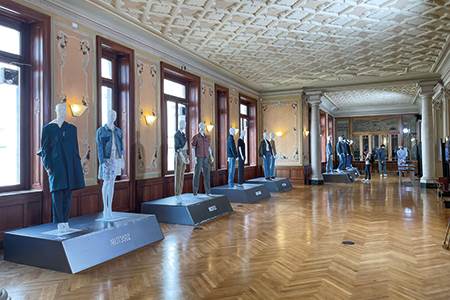Putting Genoa back on the map

The city of Genoa would like to remind denim lovers that it made a significant contribution to the world of jeans, through the very term itself, derived from its historic indigo-dyed fustian fabrics. The second edition of Genova Jeans, held last October, aspires to add a new chapter to the city’s cultural attractions and mark a new date in the denim world’s calendar.
The connection between Genoa and jeans is twofold, as it originates from both a heavy cotton twill fabric, fustian, and from its colour, dyed with indigo. The term jean, according to the Oxford Dictionary of English, is a mutation of the pronunciation of these Genoese-made fabrics. The noun, it says, comes from the Old French name for Genoa, Janne. In the 16th century, when the cotton cloth was shipped to Britain, Janne fustian, literally ‘fustian from Genoa’, was shortened to “jean”.
Anecdotally, before the launch of Inside Denim, one of the headings the team seriously considered was to be named 473 km, roughly the distance between Nîmes, where denim fabrics were first created, and Genoa, which gave the world the word for jeans. Despite its appealing historical reference, it did not make it into the publication, perhaps because fustian fabrics are no longer associated with jeans and Nîmes is no longer on the map as a supplier of denim fabrics.
The global denim industry has since moved far beyond its two founding cities, but it can be argued that jeans are much more than just a global industry, they have become a global culture that leaves ample space to delve deeper into their history and legacy. This is what gives Genova Jeans, a city and regional authority initiative, its grounding. A first event was held in the midst of the pandemic in 2021, with its attendant limitations. The second edition, held in October 2023, set the stage for a possible recurring event dedicated to reviving the Genoese roots of jeans, with the ambition of mapping the future of the denim industry.
The four-day event featured a wide array of exhibitions, workshops and panel talks spread across the city and open to all, from denim lovers to the industry at large. The Biblioteca Universitaria hosted both the panel discussions and an overview of ‘heritage brands’. The selection, chosen to illustrate the history, development and best practices of the iconic garment, included Blue Blanket Division, which specialises in raw denim, and Diesel’s Rehab Denim made from recycled cotton fibres, partially recovered from existing Diesel fabrics, along with recycled elastane and Tencel x Refibra lyocell. Mud Jeans, Pepe Jeans, and Italy’s first blue jeans brand Roy Rogers, founded in 1952, were also on display.
One of the city’s modern art museums, the Edificio Metelino, located in the dock area, opened its doors to next-generation denim designers. Andrea Grossi presented designs made from leftover fabrics made by Isko and Gilberto Calzolari chose fabrics using the Turkish mill’s most sustainable technologies. Gimmijeans opted to reintroduce hemp denim, in reference to the trousers that Genoese sailors would make out of used hemp sails. Jeanne Friot’s faux fur jacket, dyed with natural indigo, was also on show, as was a silhouette by zero-waste label Zerobarracento cut from a denim fabric woven by Berto.
The same space featured an exhibition of artworks, some never shown before, by contemporary artists from Italy and abroad. They were all made from fabrics donated by Candiani Denim and gifted to the city.
Art and industry
Denim industry suppliers also participated in the event, showing their goods in the former Oratorio di San Tommaso. Here, visitors could discover a selection of innovative companies spanning the entire supply chain. Soko, Tonello, Circulose and YKK presented their latest developments. Candiani showcased its Coreva stretch yarn, Officina39 its dyes made from old fabrics, and Pure Denim its cupro-based fabric made from Bemberg by Asahi Kasei, to name a few.
Two series of panel talks, organised on the first and second days of the event, covered an array of topics and targeting a public seeking to work in the industry or curious to delve into its future prospects. Circularity was the main theme of the Saturday morning session. One of these, moderated by CoCircular Lab founder Adriana Galijasevic, featured Kering’s head of denim, Caterina Tonda, and Angela Antolini, a representative of the Cradle-to-Cradle Institute. Joining via video were Unspun co-founder Walden Lam and Lorenzo Albrighi. The former Etro designer is the founder of Spin.Fashion, a start-up developing digital technologies to reduce waste in the fashion industry.
Furthering the strong cultural agenda of Genova Jeans, Blue Tailoring, a consultancy founded by Corinna and Stefano Chiassa, presented a book that brings together their research into denim’s heritage, based on their extensive archives, and explores new technologies and materials drawn from their work with brands. The coffee table tome includes developments from more than 30 companies working in denim.
The exceptional I Teli della Passione, housed in the Diocesano Museum, were another highlight of the event. These fourteen large indigo-dyed linen and cotton cloth wall coverings were painted with white lead by Teramo Piaggio and his workshop in 1540. They are striking early precursors of today’s jeans.
Genova Jeans’ ambition to present a very broad overview of the world of denim makes the event truly unique. Creating meaningful discussions that can appeal to both consumers and industry professionals was, for some, a stretch, as is Genoa’s link to today’s industry. For others, it offers a space to reflect on industry practices. “Business as usual is no longer possible,” as one visitor told Inside Denim. That, in a nutshell, is the challenge inherent in creating an international venue that seeks to bridge the past and the future of jeans.
An exhibition presented a selection of heritage brands, chosen for their contribution to the history, evolution and best practices of denim, in the Biblioteca Universitaria.
Photo: WTP










